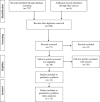Exercise, adipokines and pediatric obesity: a meta-analysis of randomized controlled trials
- PMID: 28017965
- PMCID: PMC5382285
- DOI: 10.1038/ijo.2016.230
Exercise, adipokines and pediatric obesity: a meta-analysis of randomized controlled trials
Abstract
Background/objective: Adipokines are involved in the etiology of diabetes, insulin resistance, and the development of atherosclerosis and other latent-onset complications. The objective of this meta-analysis was to determine the effectiveness of exercise interventions on adipokines in pediatric obesity.
Subjects/methods: A computerized search was made using three databases. The analysis was restricted to studies that examined the effect of exercise interventions on adipokines (adiponectin, leptin, resistin and visfatin) in pediatric obesity (6-18 years old). Fourteen randomized controlled trials (347 youths) were included. Weighted mean difference (WMD) and 95% confidence intervals were calculated.
Results: Exercise was associated with a significant increase in adiponectin (WMD=0.882 μg ml-1, 95% CI, 0.271-1.493) but did not alter leptin and resistin level. Likewise, exercise intensity and change in body fat; as well as total exercise program duration, duration of the sessions, and change in body fat all significantly influenced the effect of exercise on adiponectin and leptin, respectively.
Conclusions: Exercise seems to increase adiponectin levels in childhood obesity. Our results also suggested that exercise on its own, without the concomitant presence of changes in body composition levels, does not affect leptin levels.
Conflict of interest statement
The authors declare no conflict of interest.
Figures



Similar articles
-
Effects of Physical Exercise on Adiponectin, Leptin, and Inflammatory Markers in Childhood Obesity: Systematic Review and Meta-Analysis.Child Obes. 2018 May/Jun;14(4):207-217. doi: 10.1089/chi.2017.0269. Epub 2018 May 15. Child Obes. 2018. PMID: 29762052 Free PMC article.
-
The effect of metformin on adipokines levels: A systematic review and meta-analysis of randomized-controlled trials.Diabetes Res Clin Pract. 2024 Jan;207:111076. doi: 10.1016/j.diabres.2023.111076. Epub 2023 Dec 26. Diabetes Res Clin Pract. 2024. PMID: 38154535
-
FGF21 deficiency is associated with childhood obesity, insulin resistance and hypoadiponectinaemia: The BCAMS Study.Diabetes Metab. 2017 Jun;43(3):253-260. doi: 10.1016/j.diabet.2016.12.003. Epub 2017 Jan 27. Diabetes Metab. 2017. PMID: 28139438
-
Adiponectin, Resistin, and Visfatin in Childhood Obesity and Exercise.Pediatr Exerc Sci. 2015 Nov;27(4):454-62. doi: 10.1123/pes.2014-0072. Epub 2015 Apr 22. Pediatr Exerc Sci. 2015. PMID: 25902558 Review.
-
Adipokines and their relation to maternal energy substrate production, insulin resistance and fetal size.Eur J Obstet Gynecol Reprod Biol. 2013 May;168(1):26-9. doi: 10.1016/j.ejogrb.2012.12.009. Epub 2012 Dec 29. Eur J Obstet Gynecol Reprod Biol. 2013. PMID: 23280283
Cited by
-
Beneficial Effects of Adiponectin on Glucose and Lipid Metabolism and Atherosclerotic Progression: Mechanisms and Perspectives.Int J Mol Sci. 2019 Mar 8;20(5):1190. doi: 10.3390/ijms20051190. Int J Mol Sci. 2019. PMID: 30857216 Free PMC article. Review.
-
Effect of Exercise Training on Body Composition and Inflammatory Cytokine Levels in Overweight and Obese Individuals: A Systematic Review and Network Meta-Analysis.Front Immunol. 2022 Jun 23;13:921085. doi: 10.3389/fimmu.2022.921085. eCollection 2022. Front Immunol. 2022. PMID: 35812437 Free PMC article.
-
Cardiorespiratory Fitness Predicted by Fibrinogen and Leptin Concentrations in Children with Obesity and Risk for Diabetes: A Cross-Sectional Study and a ROC Curve Analysis.Nutrients. 2021 Feb 19;13(2):674. doi: 10.3390/nu13020674. Nutrients. 2021. PMID: 33669882 Free PMC article.
-
Effects of an exercise program on hepatic metabolism, hepatic fat, and cardiovascular health in overweight/obese adolescents from Bogotá, Colombia (the HEPAFIT study): study protocol for a randomized controlled trial.Trials. 2018 Jun 25;19(1):330. doi: 10.1186/s13063-018-2721-5. Trials. 2018. PMID: 29941024 Free PMC article.
-
Relationship between children physical activity, inflammatory mediators and lymphocyte activation: possible impact of social isolation (COVID-19).Sport Sci Health. 2021;17(2):431-439. doi: 10.1007/s11332-020-00719-2. Epub 2020 Nov 23. Sport Sci Health. 2021. PMID: 33250935 Free PMC article.
References
-
- Kershaw EE, Flier JS. Adipose tissue as an endocrine organ. J Clin Endocrinol Metab 2004; 89: 2548–2556. - PubMed
-
- Ronti T, Lupattelli G, Mannarino E. The endocrine function of adipose tissue: an update. Clin Endocrinol 2006; 64: 355–365. - PubMed
-
- Barseghian A, Gawande D, Bajaj M. Adiponectin and vulnerable atherosclerotic plaques. J Am Coll Cardiol 2011; 57: 761–770. - PubMed
-
- Sabbatini AR, Fontana V, Laurent S, Moreno H. An update on the role of adipokines in arterial stiffness and hypertension. J Hypertens 2015; 33: 435–444. - PubMed
-
- Gulcelik NE, Usman A, Gürlek A. Role of adipocytokines in predicting the development of diabetes and its late complications. Endocrine 2009; 36: 397–403. - PubMed
Publication types
MeSH terms
Substances
LinkOut - more resources
Full Text Sources
Other Literature Sources
Medical
Miscellaneous

